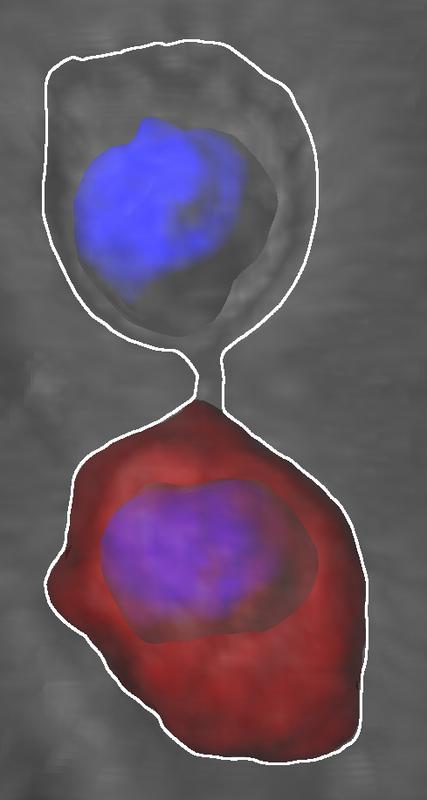A barrier against brain stem cell aging

Dividing neural stem cells establish a diffusion barrier. It participates in the asymmetric segregation of aging factors such as ubiquitinated, damaged proteins (red) during cell division. UZH
Yeast are good for making wine, bread, and brewing beer. But they are also a good model for neural stem cells in the mammalian brain. It was known that with every division cellular aging factors are asymmetrically distributed between the mother and the daughter cell, allowing for rejuvenation and full life span of the daughter independent of the age of the mother cell. At least partially responsible for this is the presence of a diffusion barrier that restricts movement of molecules from one side to the other side of the cell during cell division.
Disposing of age
A group of scientists led by Sebastian Jessberger of the Brain Research Institute showed now that also the stem cells of the adult mouse brain asymmetrically segregate aging factors between the mother and the daughter cells.
Responsible for this is a diffusion barrier in the endoplasmic reticulum (a channel system within the cell that is for example important for protein synthesis and transport). The barrier prevents retention of damaged proteins in the stem cell daughter cell keeping the stem cells relatively clean. «Neural stem cell divisions appear to be much more asymmetric than we had previously anticipated,» states Darcie Moore, postdoc in the group of Sebastian Jessberger and lead author of the study.
Barrier weakening
In addition, the authors of the new study published in «Science» found that the strength of the barrier weakens with advancing age. This leads to reduced asymmetry of damaged protein segregation with increasing age of the stem cell. This could be one of the mechanisms responsible for the reduced regeneration capacity in the aged brain as stem cells that retain larger amounts of damaged proteins require longer for the next cell division.
Sebastian Jessberger says: «This is an exciting new mechanism involved in stem cell division and aging. But as of now we are only just beginning to understand the molecular constituents and the true meaning of the barrier for stem cell division in the brain.» One key question to be answered is whether the barrier is established in all somatic stem cells of the body. The answer to this question may open new routes to target age-dependent alterations of stem cell activity in human disease.
Other researchers involved were Gregor-Alexander Pilz, Brain Research Institute, UZH, Marcos Arauzo-Bravo, Biodonostia Health Research Institute, San Sebastian and Yves Barral, Institute of Biochemistry, ETH Zurich. The work was supported by the Swiss National Science Foundation, the Zurich Neuroscience Center of UZH and ETH Zurich, the EMBO Young Investigator Program, the ETH Fellow program, the ERC, and the Human Frontier Science Program.
Literature:
Darcie L. Moore, Gregor-Alexander Pilz, Marcos J. Araúzo-Bravo, Yves Barral, Sebastian Jessberger. A mechanism for the segregation of age in mammalian neural stem cells. Science, 17 September 2015. doi:10.1126/science.aac9868
Media Contact
All latest news from the category: Life Sciences and Chemistry
Articles and reports from the Life Sciences and chemistry area deal with applied and basic research into modern biology, chemistry and human medicine.
Valuable information can be found on a range of life sciences fields including bacteriology, biochemistry, bionics, bioinformatics, biophysics, biotechnology, genetics, geobotany, human biology, marine biology, microbiology, molecular biology, cellular biology, zoology, bioinorganic chemistry, microchemistry and environmental chemistry.
Newest articles

NASA: Mystery of life’s handedness deepens
The mystery of why life uses molecules with specific orientations has deepened with a NASA-funded discovery that RNA — a key molecule thought to have potentially held the instructions for…

What are the effects of historic lithium mining on water quality?
Study reveals low levels of common contaminants but high levels of other elements in waters associated with an abandoned lithium mine. Lithium ore and mining waste from a historic lithium…

Quantum-inspired design boosts efficiency of heat-to-electricity conversion
Rice engineers take unconventional route to improving thermophotovoltaic systems. Researchers at Rice University have found a new way to improve a key element of thermophotovoltaic (TPV) systems, which convert heat…



